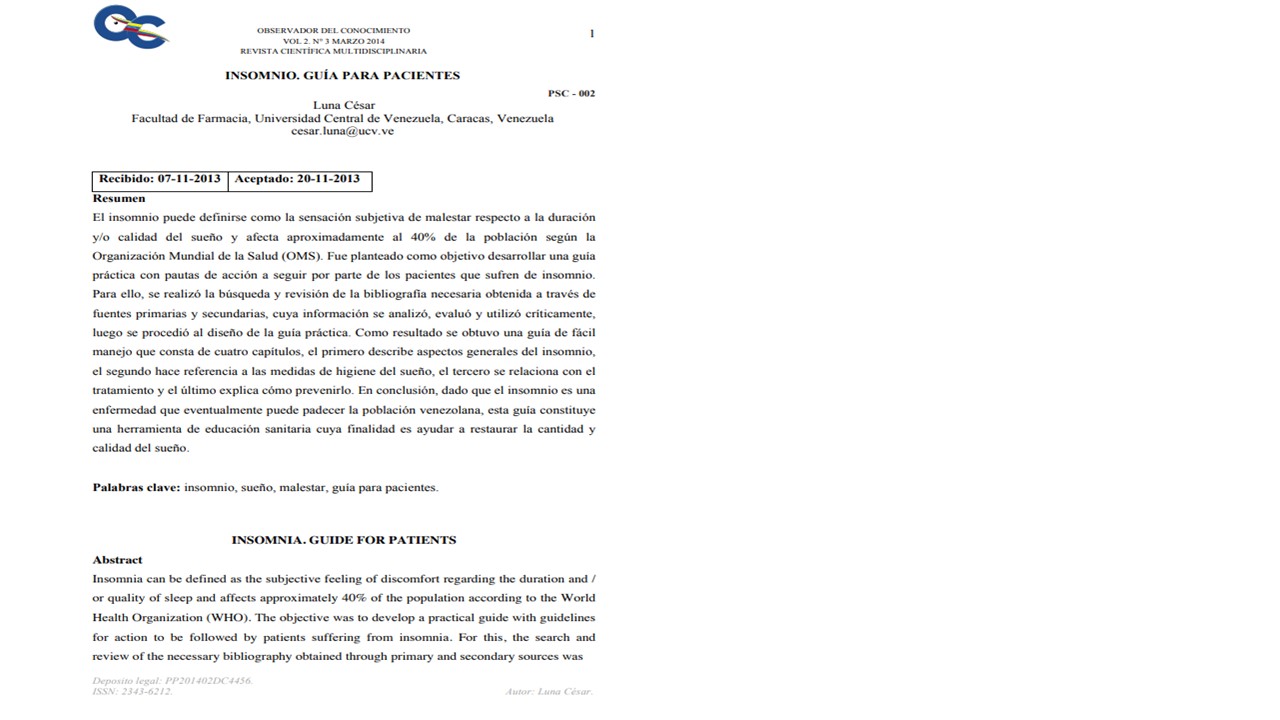Insomnia. Guide for Patients
Keywords:
Insomnio, sleep, malaise, patient guideAbstract
Insomnia can be defined as the subjective feeling of discomfort regarding the duration and / or quality of sleep and affects approximately 40% of the population according to the World Health Organization (WHO). The objective was to develop a practical guide with guidelines for action to be followed by patients suffering from insomnia. For this, the search and review of the necessary bibliography obtained through primary and secondary sources was carried out, whose information was analyzed, evaluated and used critically, then proceeded to the design of the practical guide.
Downloads
References
Allen, S. (2005). Insomnia and its management. 274: The Pharmaceutical Journal. 243-246.
Benaim, M. (2005). Estudio Descriptivo Comparativo-Psicológico y Polisomnográfico de Adultos no Insomnes e Insomnes Crónicos. Trabajo de Ascenso. Caracas: Universidad Simón Bolívar.
Bogan, R.; Turner, J. (2 0 0 7). News assessment tools that measure sleep vital signs: The SleepMed Insomnia Index and the Sleep Matrix. Neuropsychiatric Disease and Treatment. 3(4): 501–510.
Byusse, D. (2008). Insomnio Crónico. 11(8): (pp. 457-465). American Journal Psychiatry (Ed. Esp).
Carretero, M. (2006). Insomnia. OFFARM. 25(6): 90–92.
Costa, J. (2 0 0 6). Sleep disorders in psichiatry. Metabolism Clinical and Experimental. 55(2): .40-44.
Doghramji, K. (2006). The Epidemiology and Diagnosis of Insomnia. The American Journal of Managed Care. 12(8): 214-218.
Hajak, G.; Riemann, D. (2008). Chronic Insomnia. 1(1) :(pp. 36-39). European Psychiatric Review.
Hulisz, D.; Duff, C. (2009). Assisting Seniors with Insomnia: A Comprehensive Approach. US Pharmacist. 34(6): 38–43.
Johnson, E.; Roth, T.; Breslau, N. (2006). The association of insomnia with anxiety disorders and depression: Exploration of the direction of risk. Journal of Psychiatric Research. 40:700–708.
López, M. (2006). Insomnio.. OFFARM. 25(7): 60-63.
Maestre, M. (2006). Guía de Atención Farmacéutica en Insomnio. Sevilla (España): Área de Atención Farmacéutica del Colegio de Farmacéuticos de Sevilla.
Plante, D.; Winkelman, J. (2008). Alteraciones del sueño en el trastorno bipolar: implicaciones terapéuticas. American Journal Psychiatry (Ed Esp). 11(9):540-553.
Rosas, M. (2007). Insomnio clasificación, prevención y tratamiento farmacológico. OFFARM. 26(3): 90–97.
Roth, T. (2007). Insomnia: Definition, Prevalence, Etiology, and Consequences. Journal of Clinical Sleep Medicine. 3(5): 7-10.
Roth, T.; Roehrs, T.; Pies, R. (2007). Insomnia: Pathophysiology and implications for treatment. Sleep Medicine. 11(1): 71–79.
Salinas, P. (2011). El insomnio ¿Le quita el sueño? MedULA. 20: 99-101.
Serrano, M. (2 0 0 7). Información pertinente para los pacientes que sufren de insomnio. Infármate. 11: 1-8.
Sivertsen, B.; Nordhus, I. (2007). Management of insomnia in older adults. British Journal of Psychiatry. 190:285-286.

Downloads
Published
How to Cite
Issue
Section
License

This work is licensed under a Creative Commons Attribution-NoDerivatives 4.0 International License.







